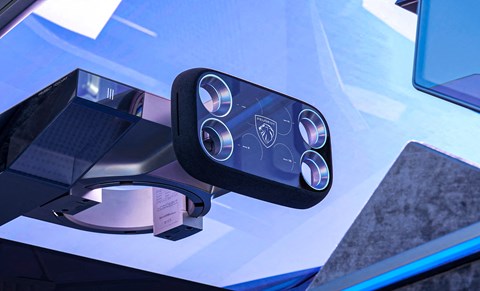► New tech examined: Peugeot Hypersquare
► A new kind of square steering wheel, or yoke
► Seen on Inception concept, coming in 2026
When you’re part of the giant Stellantis group, the good news is considerable economies of scale. The bad news? The battle to differentiate: the badge on the nose will only get you so far. Peugeot’s new e-3008, for example, will be the first car on Stellantis’ STLA Medium platform. But that head start (which nets the electric crossover an eye- brow-raising range of 435 miles) won’t last as other group brands get their hands on the same engineering.
Technology, done right, is a key weapon in this struggle – and one even notoriously cost-conscious Stellantis overseer Carlos Tavares will sign off. But with each brand permitted just a couple of these R&D-intensive wild cards, choosing wisely is key.
‘It’s like having a menu,’ Peugeot CEO Linda Jackson tells CAR. ‘You choose a couple of unique selling points and they remain exclusive. For example, i-Cockpit [introduced in 2012] is exclusive to Peugeot, just as Hypersquare will be exclusively Peugeot. Of course, Mr Tavares has a view. But the technology we choose is my responsibility.’

Hypersquare, debuted recently on Peugeot’s CES show car, Inception (above), taps into several recent trends, with the ‘steering wheel’ retracting out of sight when you move to autonomous control and a vaguely rectangular, or yoke, shape. It’s part of a radical cockpit rethink that ditches many of the traditional interior forms.
Hypersquare: the steering wheel to replace i-Cockpit
Billing it as an evolution of i-Cockpit (a combination of compact, high-set driver’s display and small-diameter, unobstructive steering wheel), Peugeot describes Hypersquare as an ‘intuitive and agile’ driving experience ‘inspired by video games’ that ‘does away with the conventional steering wheel in favour of digital controls and steer-by-wire technology’.
Encouragingly, the way it works is implicit in the design. Grasp the rectangle’s short sides. Your thumbs – prime movers in the world of video games, of course – are then free to wander into the four round recesses within the wheel. There they can make inputs without you having to release the wheel. Pictograms denote the function of each recess, be it volume, climate control or driver assists.
Worried about awkward wheel-twirling and a corresponding lack of steering lock?. Hypersquare goes hand-in-hand with steer-by-wire, which decouples the mechanical link between steering wheel and front wheels, as Toyota’s bZ4X also does, for example. And as an aside, the potential for breathtaking agility is almost limitless.

‘Will performance as we used to understand it be the performance criteria we talk about in the future? When you’ve got Hypersquare and you’ve got steer-by-wire, you have ingredients that are about sensation and instinctive driving pleasure,’ says Jackson.
If Hypersquare sounds far-fetched, consider that i-Cockpit, now 10 years old, looks weird. Then you try it and realise it’s borderline genius. And Peugeot is already testing Hypersquare ahead of its planned 2026 production debut, to mostly positive feedback, it claims.
But why risk it messing with such a proven concept?
Jackson is succinct on the challenge. ‘We need to find new customers – every manufacturer does. Because if you stick with baby boomers eventually you have a bit of a problem… You’ve got to look into the future, be confident and say, “Okay there’s going to be change.” Because otherwise you’re always going to keep producing the same cars.
‘But it’s about balance. You don’t want to over-complicate with too much technology. We get so many messages back from our cars, and we can see when people are using certain technologies. With some of these [technologies], only maybe five per cent of customers actually use them, and there are lots of examples. Some people don’t like lane departure warning – a high percentage of owners don’t use that. But then you can’t necessarily just take it off be- cause of course it’s about security and safety. Any technology we do introduce, it’s got to make a difference.’
And it’s got to be good. Lane departure warning you can turn off. Hypersquare? Not so much.